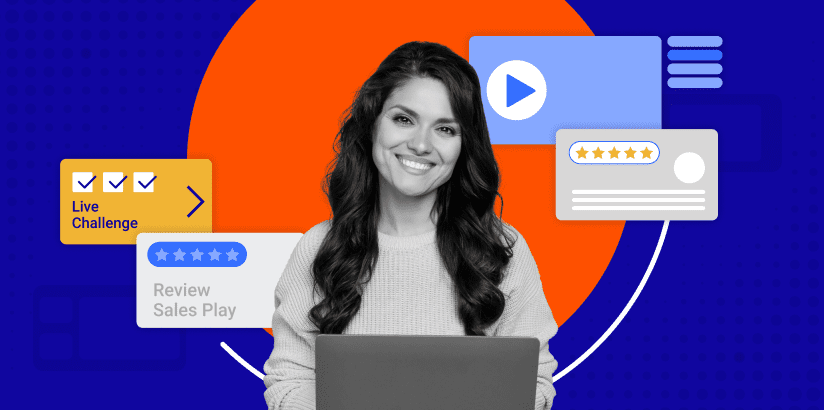Sales enablement professionals play an essential role in ensuring the revenue team is ready for any deal that comes their way. But at a time when customer expectations are high and quota attainment is low, the job of a sales enablement professional isn’t easy.
Sales enablement teams are responsible for building and executing high-impact programs and initiatives that improve sales onboarding, accelerate ramp time, and ensure sellers can be as effective and efficient as possible. But while the expectations placed on sales enablement teams continue to grow, their headcounts and budgets often remain flat—or even shrink.
For sales enablement teams, the pressure is on to do more with less.
This may sound like a tall order, but with the right strategy, tools, and technology, it’s definitely possible to build a high-impact sales enablement program—even when resources are tight.
In this guide, we’ll provide an overview of a sales enablement program and why it’s important. Then, we’ll share seven tried-and-true tips and techniques for building a high-impact program that equips each of your sales reps to close more deals faster.
Sales enablement program – What is it and why is it important for sales teams?
Sales enablement programs refer to how sales enablement professionals structure and present training and content related to a specific initiative, topic, or theme. They’re a combination of activities, assets, and resources wrapped together to execute sales enablement at scale for different scenarios. These activities can be delivered on-demand, live, or both.
The ultimate goal of a sales enablement program is to make sellers better prepared, more knowledgeable, and more effective in the field. Sales enablement teams typically train them on a topic and then provide hands-on practice and reinforcement to ensure that sellers remember the information and can translate what they’ve learned into in-field behaviors.
Different assets and activities act as the building blocks for the program and can come in various formats and modalities. They typically include training videos, instructor-led sessions, interactive role-plays, assessments and quizzes, writing exercises, marketing materials or other PDFs, gamified challenges, and more.
But the keyword here is variety.
If every program follows the same format and contains the same types of assets, sellers will get bored and tune out quickly. But we’ll get into that more in tip #1.
There are sales enablement programs for almost every topic under the sun. But we typically see programs categorized into these key use cases consistently across sales organizations:
- Sales onboarding
- Competitive takeout
- Marketing messaging and positioning
- Product training
- Product releases & updates
- Sales methodology
- Sales skills, like discovery, negotiation, prospecting, storytelling, and more
- Sales processes and tools
- Coach-the-coach
- Pricing and packaging
7 tips for creating a high-impact sales enablement program
As mentioned, not every sales enablement program is created equal. And that’s why the outcomes of enablement programs can vary widely from one organization to the next.
For example, Company A and Company B both enabled their sellers on a new quoting process, and each assigned them a program to complete that consists of the following:
Which company do you think experienced higher adoption of the new process? Duh! Company B! Company B’s program had a higher impact because it was more interactive and more engaging, and as a result, they’re more likely to see adherence to the new process.
But creating a high-impact sales enablement program is easier said than done. It’s a lot easier to assign a PDF for sellers to read and call it a day than it is to create a new and interesting piece of content.
That’s why our tips for creating a high-impact program include not only the types of activities that go into the program itself but also the tools that sales enablement leaders have to create those activities as quickly and easily as possible.
#1 Capture the seller’s attention from the first click
A high-impact enablement program delivers modern sales content and training, and that experience starts with the seller’s first interaction with and impression of the program. That’s why you need to create engaging, immersive experiences for sellers.
One way is by intuitively displaying the program content and training with relevant context. This eliminates any potential sense of confusion or lostness, which typically hampers seller completion.
From the first click, sellers should understand:
- Program purpose and goal: What they will learn and how it help them crush their quota
- Program outcome: What they expect to earn, whether a certificate, approval to sell a new product line, etc.
- Program path and milestones: What activities do they need to complete, in what order, and in what context of how does that connect back to the program goal
Additionally, once they begin the program, you need to ensure there is variation in the format and types of activities. Like Company B, you must ensure you’re leveraging a sales enablement platform that arms you with both breadth and depth in the building blocks you can use to build the program. This includes on-demand, interactive, and instructor-led elements, all available side-by-side with unified reporting.
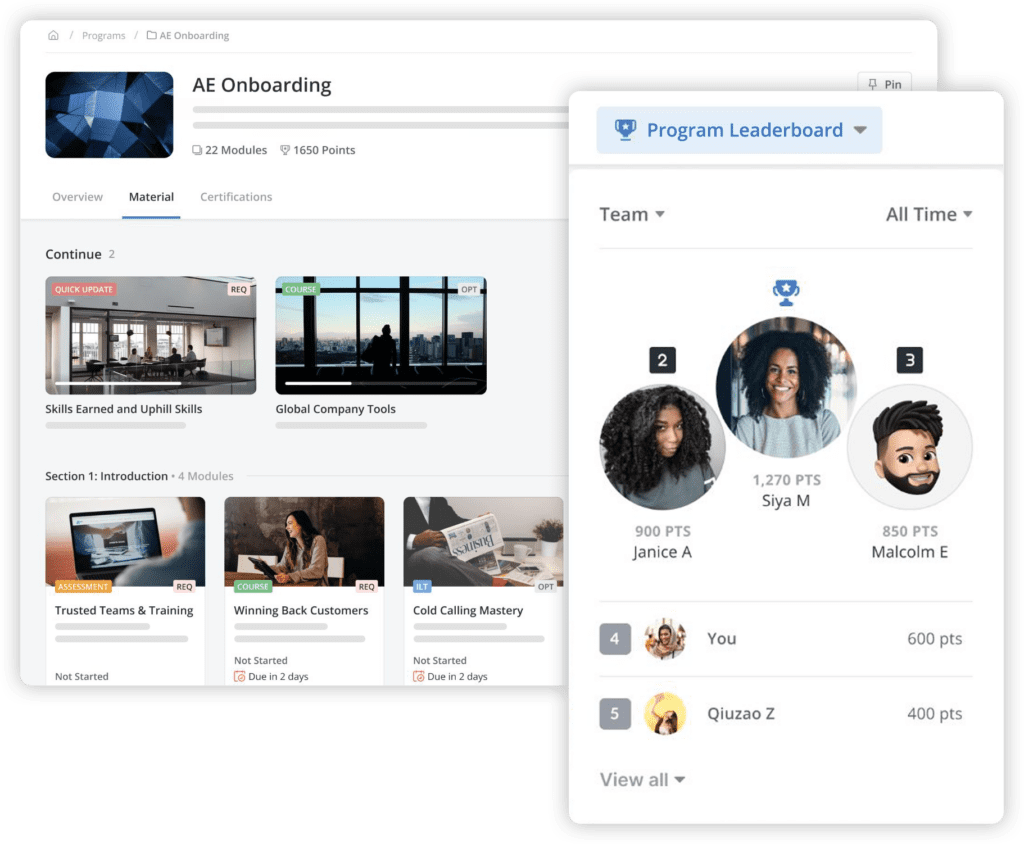
#2 Combines training and content side by side
While training and content on a particular topic are good, like any dynamic duo, they’re more powerful together. That’s why a high-impact sales enablement program not only provides training on a relevant topic but also presents it side by side with the associated relevant content that sellers will use post-training.
For example, if you’ve launched a program on new marketing messaging, don’t make sellers search for and access the new pitch decks and marketing collateral elsewhere. Provide it right there in the program for easy access.
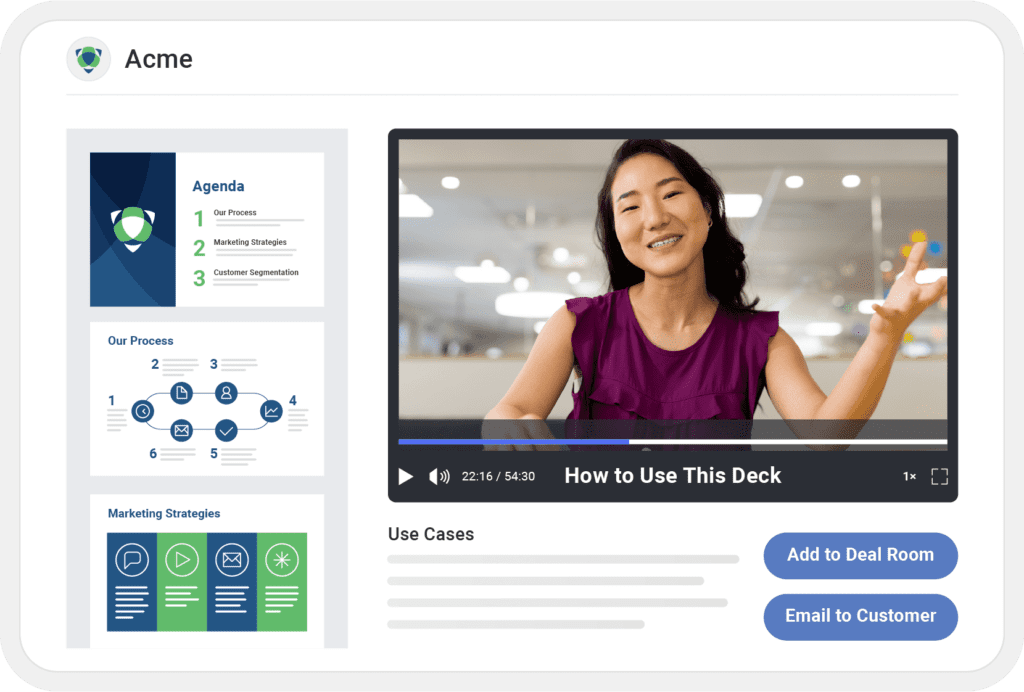

#3 Make the program interactive
We’ve all done our fair share of multitasking while brainlessly clicking through a long enablement video. That’s why high-impact enablement programs are heavy on interactive, hands-on elements to ensure sellers to stay engaged and reinforce knowledge and skills throughout.
Some common interactive elements include:
Asking questions and conducting surveys periodically within video content increases engagement on content and performs just-in-time knowledge checks
Assign prompts and scenarios for sellers to record role-play or written exercises to ensure comprehension and ensure sellers can apply the concept and articulate it in their own words.
Include snippets from real-world customer calls, peer role-play submissions, and peer success stories to make the content more relatable and bring it to life.
Incorporating point-keeping, leaderboards, badges, competitions, team activities, and other game-like features into your enablement program boosts concentration and participation.
#4 Create built-in certifications
Becoming certified in a topic or process is a motivating factor for many high-impact enablement programs. However, sales enablement leaders need to be able to scale and automate certification efforts easily. They need to be able to track seller performance on individual learning components in the program, award certificates using complex criteria, and manage recertifications as necessary.
Certifications also motivate sellers and partners when a social component is incorporated. Making it easy for sellers to share their certifications on social platforms like LinkedIn from within your sales enablement platform creates a sense of reward and recognition. Customizing your certificates to your brand, product, or initiative also boosts your brand awareness.
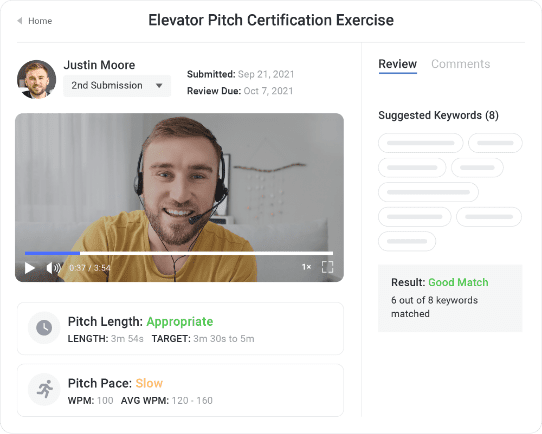

#5 Individualized to sellers’ needs
Even the best, most riveting sales enablement program won’t be high-impact if it’s one-size-fits-all. Programs need to be relevant and personalized at scale, focusing on each rep’s unique needs and the skills that will move the needle for them.
Leading sales enablement platforms provide automation that adjusts programs to sellers’ skillsets and competencies. Not forcing sellers to complete components of the program focused on knowledge, skills, or behaviors they’ve already mastered generates more buy-in and engagement for programs as a whole.
#6 Use program templates
As mentioned, sales enablement teams are usually short on time and resources, which can drain the creativity juices from even the most innovative sales enablement professional.
That’s why using a sales enablement platform that provides quick-start tools like templates is key to program creation. Top sales enablement vendors provide pre-built yet customizable templates for key sales enablement use cases, eliminating blank page paralysis and accelerating program creation.
From the 2024 State of Revenue Productivity Report, we found that using program templates decreased the time to launch a program from 3-4 weeks to 7 days.
Days to launch a program
These templates include pre-built best practices and engagement mechanics which provide the blueprint for the best structure and pieces of content for each use case.
#7 Leverage industry expertise and pre-made program content
Ready-to-deploy content is similar to, yet different from, program templates. While templates provide the blueprint for a high-impact program, ready-to-deploy programs provide the whole enchilada.
There are key topics that sales enablement leaders worldwide across different companies are all enabling their people on. Think sales discovery, cross-sell and upsell, objection handling, certain sales methodologies like MEDDPICC, etc. But all of these sales enablement teams are starting from scratch, wasting valuable time, and creating the same things when they could be working on more strategic initiatives.
That’s why sales enablement platforms provide sales enablement teams with prebuilt programs on these key topics created by industry experts and top-tier sales consulting firms. This lets sales enablement teams leverage this expertise and incorporate new modalities and approaches based on modern learning design and industry best practices to stop reinventing the wheel and focus more on strategy and execution.
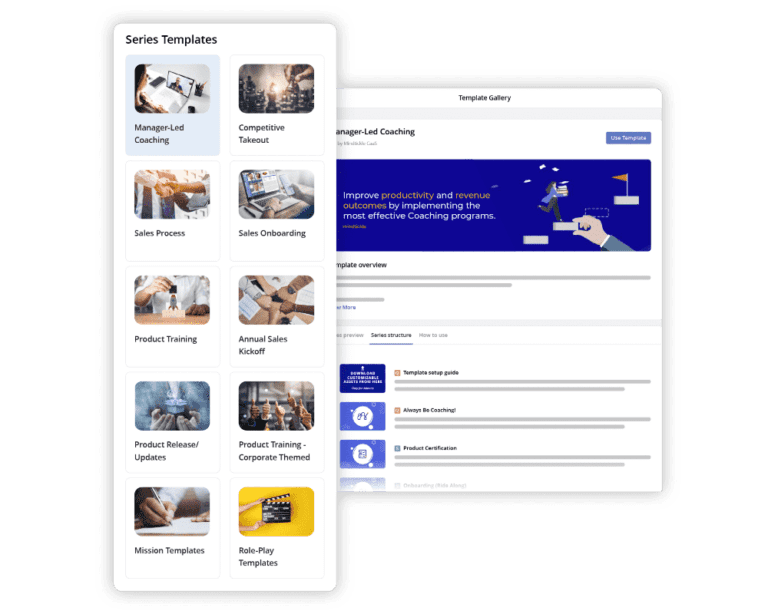

Create a high-impact sales enablement program with Mindtickle
Modern sales reps face more challenges than ever before. It’s no wonder why just 28% of sales professionals expect to meet quota.
Increasingly, organizations are turning to sales enablement to ensure their entire sales team is ready to conquer any deal that comes their way. Per Mindtickle’s 2024-2025 Chief Revenue Officer + Sales Leader Outlook Report, 84% of organizations are investing in sales enablement.
However, establishing a sales enablement department doesn’t guarantee great results. Instead, sales enablement professionals must have the right strategy and tools in place to create high-impact programs that actually improve sales outcomes.
The right technology is a key component of any sales enablement strategy. Mindtickle’s integrated revenue productivity solution incorporates sales training, sales enablement, sales content, and call insights – all in one platform. With Mindtickle, sales reps can find everything they need to be ready to sell. And sales enablement professionals can build, deliver, and measure their programs – all in one place.
Ready to see why winning revenue teams are choosing Mindtickle to power their sales enablement programs? Schedule a live demo to see for yourself.
Sales Enablement in Mindtickle
Ready to see why winning revenue teams are choosing Mindtickle to power their sales enablement programs?
Request a DemoThis post was originally published in November 2022 and was updated in May 2024.

